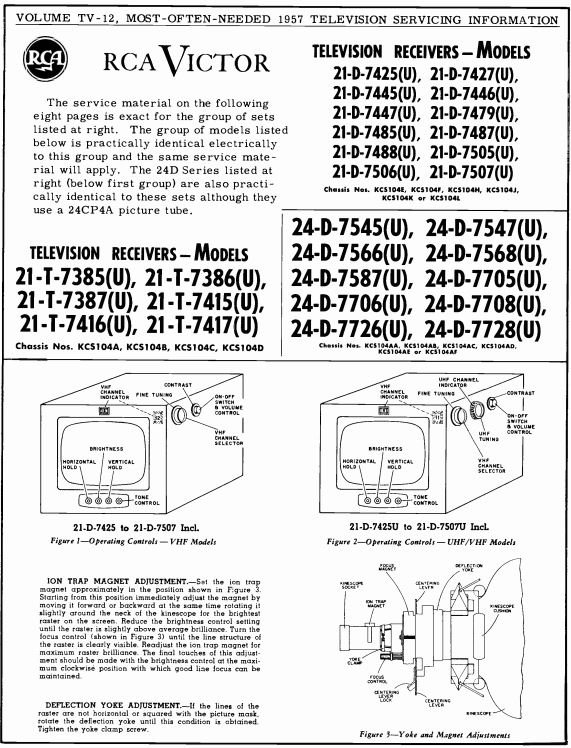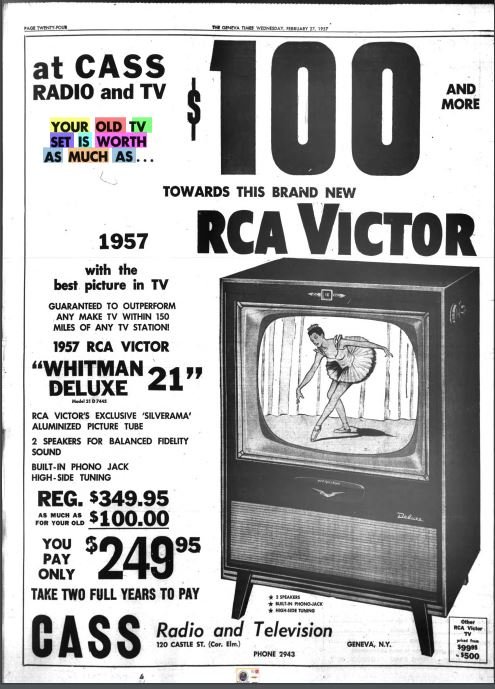The Return of the RCA TV
Radio Corporation of America (RCA) was born out of the reorganization of American Marconi in 1919. Over the next 20 years, the company would expand its empire through the creation of the National Broadcasting Company in 1926 and its acquisition of the Victor Talking Machine Company in 1929. RCA pioneered the development of TV and debuted it’s all electric, black and white television at the 1939 New York World’s Fair.
NBC is the oldest major broadcast network in the US. (The Times Union, Albany, NY, September 1926)
In 1933 RCA moved into 30 Rockefeller Plaza. (The Poughkeepsie Eagle News, March 1930)
In 1957 the RCA Victor Deluxe Model 21-D-7445U was released to the public. This model has a 21 inch black and white screen. It not only comes with the standard very high frequency (VHF) channels, 2-13 but also the ultra-high frequency (UHF) channels, 14-83. This allows viewers to watch network television favorites such as I Love Lucy and The Ed Sullivan Show but also local programs running on the higher channels. This model has two loudspeakers and features a plug in for a Victrola record player.
Service Manual highlighting the differences between the 7445 and 7445U models.
The 1950’s saw an explosion in popularity of television in the home. At the beginning of the decade as little as 9% of American households owned a TV but by 1959 almost 86% of households owned a TV. This dramatic increase in viewership cemented television as the medium of choice for mass communication. This was the first time American’s were seeing family dynamics, albeit fiction, played out on screen regularly. Experts speculate this enforced cultural and societal expectations of the ideal family image. Although still vastly under-represented, programming began to reflect the American population as minority groups gradually appeared on screens more often as guests on talk shows or as stars on their own shows. Today, there are about 122.4 million American households with at least one TV.
Advertisement depicting Model 21-D-7445
Perhaps the most notable appearance of the RCA Victor Deluxe Model 21-D-7445U was on Peewee’s Playhouse as the screen to his picture phone.
John R. Finegan (The Times Record, Troy, NY, May 1956)
The RCA Victor Deluxe in our collection was donated by John E. Finegan in 1980. Finegan was born in 1918 and was a resident of Troy for his entire life. He graduated from New York State College for Teachers in 1940 and received his master’s degree from Columbia University in 1941. He went on to teach social studies and science at East Nassau Central School until March 1942 when he was appointed to fill the junior high school principal position. After 16 years in this role, he stepped down for health reasons and resumed teaching social studies. In 1959 he became the first vice president of Averill Park’s PTA. Outside of work Finegan was an active member of his church and enjoyed traveling around the United States.
Finegan’s life uniquely parallels the growth of RCA. His birth came one year prior to the birth of the company and his collegiate journey began one year after the debut of RCA’s all electric, black and white TV. Perhaps the peak of his career came as RCA released their colored TV. Finegan’s donation gives depth to our collection because it represents the birth of one of America’s favorite mediums of mass communication at a time when it was definitively secured its place in American households. Be on the look out for the RCA Victor Deluxe in the new exhibit at the Hart Cluett Museum, The Pursuit of Happiness!
RCA Victor Deluxe Model 21-D-7445U (radiomuseum.org)
Blog post researched and written by Elliot Gnirrep







